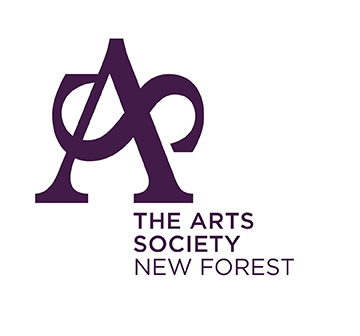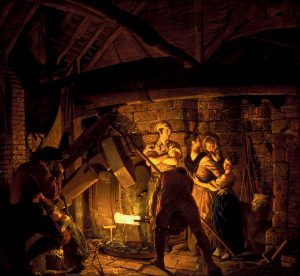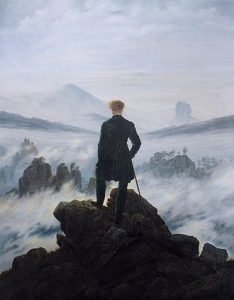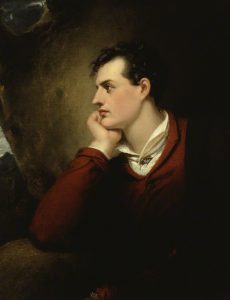
Our January lecture was given by Elizabeth Merry, who delivered a fascinating and informative lecture on Lord Byron.
Her lecture began with a description of Byron as ‘a child of his times ‘ who lived his life against a backdrop of the developing romantic era. Described by one of his lady friends as ‘mad,bad and dangerous to know.’
He lived through a time of great political unrest. The revolution in France caused great concern in England, concern that a similar revolt would occur in Britain, as depicted in this cartoon by James Gilray in 1792
‘Un Petit Souper a la Parisien ‘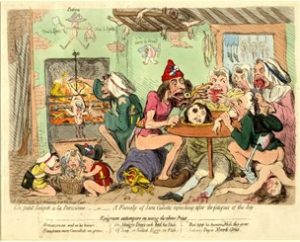
Scientific enquiry and industry were growing rapidly, as shown in this painting by Joseph Wright in 1772,-‘An Iron Forge.’
The developing middle class wanted stories and poetry and were therefore, ready for Byron.
The Byron family were a prolific and improper family. Sir Joshua Reynolds painted Byron’s grandfather – ‘Foul Weather Jack.’ in 1758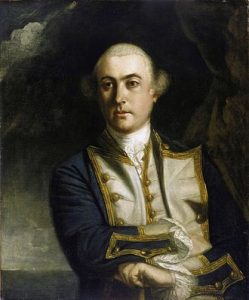
His son ‘Mad Jack’ was Byron’s father. He married Byron’s mother – Katherine Gordon 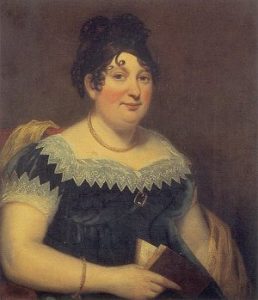 for her money but, within 18 months all her money had been spent.
for her money but, within 18 months all her money had been spent.
Painting of Katherine by Thomas Stewardson
Her family background was also very disturbed and there had been many suicides.
In 1788 her baby was born in London,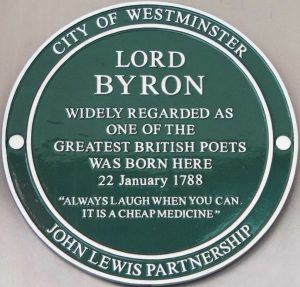 but Katherine , with no money and no husband present, returned to Aberdeen. When Byron was 3,his father died.
but Katherine , with no money and no husband present, returned to Aberdeen. When Byron was 3,his father died.
George Byron (as he was named) had inherited some of the darker aspects of his family and also a deformed foot. He was called ‘Mrs. Byron’s Crooked Devil’ and was bullied at school for this deformity, but he learned to fight hard and defend himself.
At 9, he inherited the Byron Estate; but it was mortgaged and derelict. A grant, however, enabled him to go to Harrow where he became very romantic and passionate with both girls and boys. At 12 he fell in love with his cousin. He had a hideous relationship with his mother who would be over affectionate one minute and full of rage another.
From Harrow he went to Trinity College, where he drank, indulged in sartorial fashion and ran up enormous debts.Whilst there he commissioned a portrait of himself in a gold embroidered gown.
He was not an excellent scholar and did not throw himself into his studies but whilst at Trinity he made life-long friends.
After Trinity he went to London and continued his rather debauched life – a life that was mocked in the painting by Thomas Rowlandson in 1800 ‘The Exhibition Stare Case’ 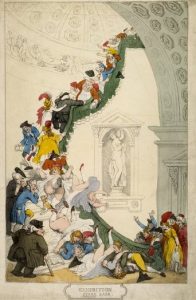
But Byron was also trying to make a mark with his poetry.
In July 1809 he set off to Portugal with his friend John Cam Hobhouse and this departure was painted by George Sanders.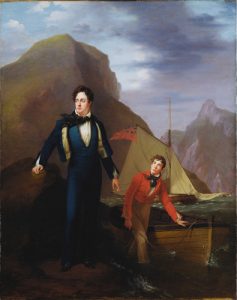 From Lisbon, Byron and his friend went to Spain and thence to Malta and then to Ottoman Turkey where they were the guests of the court of Ali Pasha.Though he was attracted to Islam, he went on to Greece where he spent a year and relit his fire of support for the struggle of the Greeks against the Turks. Whilst in Athens in 1810 he wrote ‘Maid of Athens’ for a 12 year old girl and there were suggestions of a relationship.
From Lisbon, Byron and his friend went to Spain and thence to Malta and then to Ottoman Turkey where they were the guests of the court of Ali Pasha.Though he was attracted to Islam, he went on to Greece where he spent a year and relit his fire of support for the struggle of the Greeks against the Turks. Whilst in Athens in 1810 he wrote ‘Maid of Athens’ for a 12 year old girl and there were suggestions of a relationship.
Byron was very protective of his image but he really liked this painting of himself in Albanian robes – painted by Sir Thomas Philips in 1812. In 1811 they returned to London and in 1812 his book ‘Childe Harold’s Pilgrimage’ was published and he became an immediate celebrity; sought after at every society, and worshipped by so many women -especially Caroline Lamb,
In 1811 they returned to London and in 1812 his book ‘Childe Harold’s Pilgrimage’ was published and he became an immediate celebrity; sought after at every society, and worshipped by so many women -especially Caroline Lamb,  who described him as ‘mad, bad and dangerous to know.’ The Richard Westall picture at the beginning of this article was painted at this time.
who described him as ‘mad, bad and dangerous to know.’ The Richard Westall picture at the beginning of this article was painted at this time.
He soon tired of each lady and rumours began about his liaison with half sister Augusta.
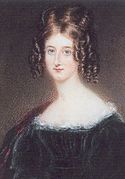 To escape these rumours and his debts, he looked for a wife; and in January 1815 he married Annabella Millbank
To escape these rumours and his debts, he looked for a wife; and in January 1815 he married Annabella Millbank 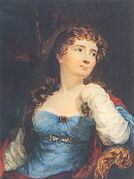 and their daughter was born in December of that year. The rumours continued and the marriage was a disaster and in 1816 Annabella left him. Byron spent 6 months with Shelley and friends in the Lake District and then left England – never to return. He spent 6 years in Italy before the old dream of a free Greece returned and he travelled to Greece to fight with the insurgents who were seeking their independence from Ottoman Turkey. But sadly, just a few months later, on April 19th 1824 he died of fever. The painting by Joseph Denis Odevare painted in 1826 shows this moment.
and their daughter was born in December of that year. The rumours continued and the marriage was a disaster and in 1816 Annabella left him. Byron spent 6 months with Shelley and friends in the Lake District and then left England – never to return. He spent 6 years in Italy before the old dream of a free Greece returned and he travelled to Greece to fight with the insurgents who were seeking their independence from Ottoman Turkey. But sadly, just a few months later, on April 19th 1824 he died of fever. The painting by Joseph Denis Odevare painted in 1826 shows this moment. His body was taken back to England and he was buried at the ancestral home in Nottinghamshire. It was a time of national mourning.
His body was taken back to England and he was buried at the ancestral home in Nottinghamshire. It was a time of national mourning.
Byron inspired many artists – including Turner, who painted this as his own homage to Byron
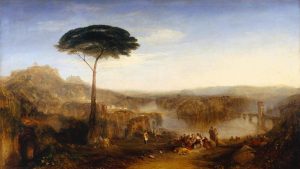
and John Martin’s painting in 1837 of
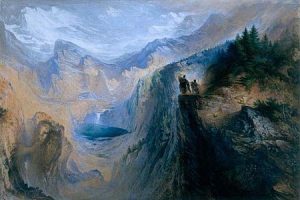 ‘Manfred on the Jungfrau’ inspired by Byron’s poem ‘Manfred’
‘Manfred on the Jungfrau’ inspired by Byron’s poem ‘Manfred’
and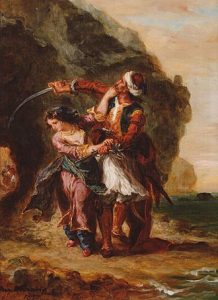 Eugene de la Croix’s painting ‘The Bride of Abydos’ painted in 1857 based on the poem of the same name written by Byron in 1813
Eugene de la Croix’s painting ‘The Bride of Abydos’ painted in 1857 based on the poem of the same name written by Byron in 1813
And finally, the figure in Casper Friedrich’s painting ‘Wanderer Above the Sea of Fog’ is thought to be Byron.
